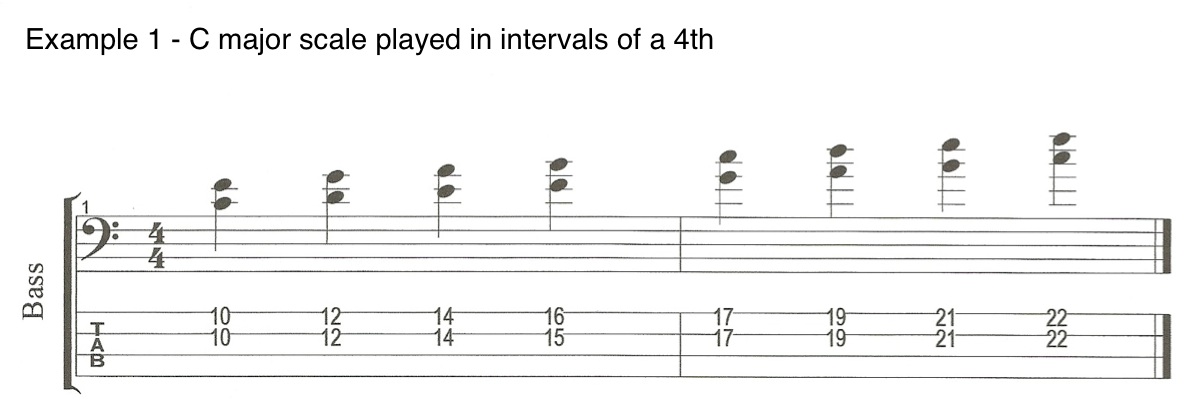Chords on the Bass – Part 2
In this second part in my series of videos about playing chords on the bass, we’re going to continue looking at how we can make chords by playing double stops (two notes played at the same time) over open strings. In Part 1 we harmonised scales into intervals of a third and in Part 2 we’re going to see how we can get a whole new set of sounds and chords by changing the interval we use to harmonise our scales.
Intervals
If you’re not sure what an interval is or how we play intervals on the bass then check out my video called Intervals which is also available on this site and it will explain everything.
In Example 1 I’m playing a C major scale harmonised into intervals of a fourth.
In Example 2 I’m playing the same C major scale played in fourths. I’m playing it over an open A string. Then in the following examples I’m still playing a C major scale over an open A string. However, I’m changing the interval that I’m using to harmonise the scale. In Example 3 I’m harmonising the C major scale in fifths and in Example 4 I’m using sixths. You can hear that each different interval gives us a different sound even though I’m harmonising the same scale over the same note.
 * I’ve marked some chords * in the above examples because they don’t contain thirds. The Am7 and Am9 chords could also function as A7 and A9 because they don’t contain the note C. Which is the minor 3rd. I’ve labeled them as minor chords because if we were to add a third in this key it would be a minor third C. Not a major third C#. The G9/A chords in Examples 2 & 3 also don’t include the 3rd B but again I’ve labeled them according to what they would be if we added a 3rd in this key. The same is true for the chords marked in the examples below.
* I’ve marked some chords * in the above examples because they don’t contain thirds. The Am7 and Am9 chords could also function as A7 and A9 because they don’t contain the note C. Which is the minor 3rd. I’ve labeled them as minor chords because if we were to add a third in this key it would be a minor third C. Not a major third C#. The G9/A chords in Examples 2 & 3 also don’t include the 3rd B but again I’ve labeled them according to what they would be if we added a 3rd in this key. The same is true for the chords marked in the examples below.
Fourths, Fifths and Sixths
The next examples are a similar idea. Only this time I’m harmonising a D major scale and playing it over an open E string. This gives us a Dorian sound. In Example 5 I’m harmonising the scale in fourths. In Example 6 I’m using fifths and in Example 7 I’m using sixths.
 Notice how in Example 7 using the open E string instead of the open A string gives us a different option for fingerings when we play the scale in sixths. We can now play the lower of the 2 notes on the A string. The higher note on the G string while we leave out the D string altogether.
Notice how in Example 7 using the open E string instead of the open A string gives us a different option for fingerings when we play the scale in sixths. We can now play the lower of the 2 notes on the A string. The higher note on the G string while we leave out the D string altogether.
These examples are just a small demonstration of some the sounds that you can come up with using this idea. It wouldn’t be impossible to list here all the possible variations you can achieve by harmonising scales over open strings. So, I really want to encourage you to experiment and come up with ideas of your own.
A melodic minor in sixths
Before I leave you, I’m going to share one more idea. Here’s what the A melodic minor scale that I introduced at the end of Part 1 sounds like when you harmonise it in sixths and play it over an open A string.
 Now move on to Playing Chords on the Bass – Part 3 – Triads. You’ll learn how we can add extensions to the triads so you can make more interesting sounding chords.
Now move on to Playing Chords on the Bass – Part 3 – Triads. You’ll learn how we can add extensions to the triads so you can make more interesting sounding chords.


